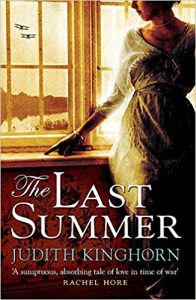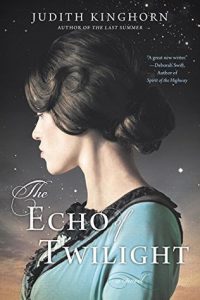A Sense of Place
 “By nightfall the headlines would be reporting devastation.
“By nightfall the headlines would be reporting devastation.
It was simply that the sky, on a shadeless day, suddenly lowered itself like an awning. Purple silence petrified the limbs of trees and stood crops upright in the fields like hair on end. Whatever there was of fresh white paint sprang out from downs or dunes, or lacerated a roadside with a streak of fencing. This occurred shortly after midday on a summer Monday in the south of England.”
– Shirley Hazzard, The Transit of Venus
In these opening lines from her novel The Transit of Venus, Shirley Hazzard ignores any rules about weather and places us where she wants us: beneath a lowering sky, waiting for a storm we already know will be devastating. The timing – shortly after midday on a Monday – may or may not be important but adds to the tension of purple silence. In four sentences, Hazzard sets the tone.
I read The Transit of Venus almost a decade ago and have probably read a few hundred books since then, but the novel’s opening has stayed with me as a vividly powerful impression of atmosphere and place. Good books do this; they leave an imprint. Often, when I think of a novel I’ve loved, it’s not the plot or even the characters that I remember, but the setting and atmosphere. Whenever I think of The Transit of Venus, I remember the opening of the novel not as words, but in an abstract, sensory way: foreboding; purple-coloured; lacerated with bright white paint.
As a reader, a sense of place adds immeasurably to my engagement with and enjoyment of a novel. As a writer, I’m in awe of my fellow writers, and those that have gone before, who are able to swiftly deliver us into place. But of course a good story can’t just rely on the spirit of a place or atmosphere alone; a novel has to have a plot, a narrative arc, and characters who grow, react to and develop within their landscape; lyricism must be used judiciously; and conflict – resulting in change to character and place – is essential.
I’ve written four novels set in the early twentieth century: a period in many ways not dissimilar to this early twenty-first century, when the changes taking place were immense. For literature, art, women’s rights, fashion, music, religion, politics and more, it was the beginning of a new and modern world, a world which required new thinking, and new understanding. This changing landscape is intrinsic to my novels. I use it to denote time, create atmosphere and tone, and to speak about the values, inclinations and foibles of my characters. I’ve used familiar landscapes, places near to me, and far flung places conjured from the darkest recesses of my memory; and I’ve used places that never existed at all.
 Landscape and place are vital components to my writing, and bricks and mortar have played a central part – another character – in each of my books. In The Last Summer, Deyning Park is a symbol of constancy through changing times and fortunes; in The Memory of Lost Senses, Temple Hill harbours secrets and lies, and offers refuge to a troubled soul; in The Snow Globe, Eden Hall represents security amidst fracturing family relationships; and The Echo of Twilight has not one but two important houses – Birling and Delnasay.
Landscape and place are vital components to my writing, and bricks and mortar have played a central part – another character – in each of my books. In The Last Summer, Deyning Park is a symbol of constancy through changing times and fortunes; in The Memory of Lost Senses, Temple Hill harbours secrets and lies, and offers refuge to a troubled soul; in The Snow Globe, Eden Hall represents security amidst fracturing family relationships; and The Echo of Twilight has not one but two important houses – Birling and Delnasay.
Not one of these houses exists in reality. Though their locations are real, and clearly identifiable, the buildings themselves exist only in this writer’s (and her readers’) imagination. Each place is the result of an amalgamation of imagery and impressions; of photographs, memories, places I’ve read about or visited. Often the starting point on an otherwise blank canvas is no more than random imagery, but it’s from this that I begin to build my own sense of place – begin to see, immerse and anchor myself. And for me, writing about landscape and place is not so very different to painting a landscape or place: both require a keen eye, and a deft, sensitive touch.
Luckily, our brains are inveterate hoarders of imagery. Consciously and unconsciously, as we move through life, we collect a vast archive of material to draw on. Within my own are endless snapshots of people and places I have known and loved, or not loved, of things lost and moments frozen in time, along with the now slightly blurred, slow-motion reels of my childhood and early life. And strangely, like books, what often glows most within that dark internal vault are not actual events, or people, but places.
Life is a sensory thing. From the moment we’re born until our last breath, we experience the world around us through our senses. Our earliest memories are bound in the imagery of place, its light and shadows, colours, textures and sounds. Most of my own early memories are set at what was once my grandparents’ house, a place I haven’t set foot in for forty years but regularly revisit – to remind myself and exercise my memory. When I write about place, I often delve back for inspiration to those early sensory perceptions – uniquely pure, unfiltered, and strangely undiluted by time.
“Once upon a time, but when, in actual time, I have no idea, a sudden searching convulsion of my whole ground of being overtakes me in the garden. I am mooching alone along the gravel path that runs between the lawn and Lover’s Walk. It is autumn, and the sun has dropped. I am not Amaranth Aurora or Beryl Diamond, or that obsessive spell-maker, murmuring as I stroll or crawl around OM MANI PADME HUM. I am almost no one, kicking up amber drifts of chestnut leaves, aware of the dark green thickets of laurel on my left, and on my right of the hoary expanse of lawn, ringed by blue deodars and cedars and already crisping with frost and sparkling in the opalescent haze of dusk.”
– Rosamond Lehmann, The Swan in the Evening
—
Judith Kinghorn is the author of four novels: The Echo of Twilight, The Snow Globe, The Memory of Lost Senses, and The Last Summer. www.judithkinghornwriter.com
Twitter @judithkinghorn
 Judith’s latest novel: THE ECHO OF TWILIGHT
Judith’s latest novel: THE ECHO OF TWILIGHT
“An enchanting, atmospheric work of historical fiction that is a rich blend of Downton Abbey andJane Eyre. The Echo ofTwilight is a wonderful novel to curl up with this winter.”–Booklist
From the acclaimed author of The Last Summer, a captivating and moving story of the unlikely relationship between a lady and her maid on the eve of World War I.
As I watched him—his long legs striding the narrow path through the heather, his golden hair catching the sun—I had a hideous feeling in the pit of my stomach. For it seemed as though he was already marching away from me.
In 1914, despite the clouds of war threatening Europe, Pearl Gibson’s future is bright. She has secured a position as a lady’s maid to a wealthy Northumberland aristocrat, a job that will win her not only respect but an opportunity to travel and live in luxury. Her new life at Lady Ottoline Campbell’s Scottish summer estate is a whirlwind of intrigue and glamour, scandals and confidences—and surprisingly, a strange but intimate friendship with her employer.
But when violence erupts in Europe, Pearl and Ottoline’s world is irrevocably changed. As the men in their lives are called to the front lines, leaving them behind to anxiously brace for bad news, Pearl realizes she must share one final secret with her mistress—a secret that will bind them together forever…
Category: Contemporary Women Writers, On Writing
























